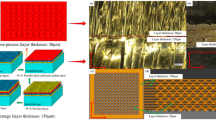Abstract
The nano cutting process of Zr-based amorphous alloy was simulated by molecular dynamics simulation in this paper. Through the research on the changing rule of cutting force in nano cutting of Zr-based amorphous alloy, it is found that the cutting force increases continuously, and the cutting rate is large at the initial stage of nano cutting, which may be related to the shear deformation of the atomic clusters or atomic clusters in the shear transition zone. The effect of cutting tool rake angle on nano cutting process for Zr-based amorphous alloy was studied. The simulation results show that the cutting force decreases with the increase of the rake angle of the cutting tool, and the friction coefficient between the rake face and the chip also decreases slightly. With the increase of the rake angle of the cutting tool, the pushing effect of the tool on the Zr-based amorphous alloy chip and the overall bending of the chip are weakened, leading to the increase of the chip height. The number of high-temperature atoms in the Zr-based amorphous alloy workpiece also decreases with the increase of the tool rake angle, and the cutting temperature distribution on the workpiece diffuses to the interior of the workpiece with the tool fillet as the center.












Similar content being viewed by others
References
Cui Z (2006) Overview of micro/nanofabrication technologies and applications [J]. Physics 01:34–39
Luo XC, Liang YC, Dong S (1999) Application of molecular dynamics in nanomachining technology [J]. China Mech Eng 06:100–104+8
Zhao D, Wang SB, Zhu B, Li LJ, Zhao HW (2019) Anisotropic deformation behaviors of amorphous-crystalline nanolaminates investigated via molecular dynamics simulations [J]. J Alloy Compd 787:649–657
Wang C, Li SJ, Chai P, Yan JC, Li Y (2018) Modeling and simulation of micro-cutting mechanism of single crystal SiC by molecular dynamics [J]. Acta Armamentarii 39(08):1648–1654
Mendelev MI, Sordelet DJ, Kramer MJ (2007) Using atomistic computer simulations to analyze x-ray diffraction data from metallic glasses [J]. J Appl Phys 102(04):043501
Duan LJ, Liu YC (2020) Relationships between elastic constants and EAM/FS potential functions for cubic crystals [J]. Acta Metall Sin 56(01):112–118
Liu YX, Sun J, Gao Y, Gu H, Liu L (2008) Several fitting methods of Lennard-Jones interatomic potential parameters [J]. J Liaoning Univ (Nat Sci) 03:206–209
Gong ZL, Zhou CB, Peng YZ (2015) Dynamics of stick-slip on interfacial friction based on the Lennard-Jones potential theory [J]. Surf Technol 44(09):36–42
Tersoff J (1989) Modeling solid-state chemistry: interatomic potentials for multicomponent systems [J]. Phys Rev B: Condens Matter 39(08):5566–5568
Xie JX, Zhou C, Zhang ZH (2003) Superplastic forming techniques for fine precision amorphous alloy parts [J]. Mater Rep 02:8–11
Bakkal M, Shih AJ, Scattergood RO (2004) Chip formation, cutting forces, and tool wear in turning of Zr-based bulk metallic glass [J]. Int J Mach Tools Manuf 44(09):915–925
Zhu ZX, Gong YD, Zhou YG, Zhang YX (2017) Molecular dynamics simulating effect of rake angle on single crystal nickel nanometric machining [J]. J Northeast Univ (Nat Sci) 38(10):1436–1441
Funding
This research was supported by National Natural Science Foundation of China (Grant No. 52005346, 52005347, 52275455 and U1908230), Natural Science Foundation of Liaoning Province (Grant No. 2021-BS-149), Scientific Research Funding Project of Liaoning Provincial Department of Education (Grant No. LQGD2020017), Project of Liaoning Province Applied Basic Research Program (Grant No. 2022JH2/101300214), Special Fund for Tackling Key Scientific and Technological Problems in Liaoning Province (Grant No. 2021JH1/10400077).
Author information
Authors and Affiliations
Contributions
All the authors contributed to the study conception and design. Material preparation, data collection, and analysis were performed by Xiaoqing Cui, Yin Liu, Xingwei Sun, and Yadong Gong. The first draft of the manuscript was written by Xiaoqing Cui and Yin Liu. Experimental tests were carried out by Heran Yang, Zewei Yuan, Zhixu Dong, and Weijun Liu. All the authors read and approved the final manuscript.
Corresponding author
Ethics declarations
Ethics approval
Not applicable.
Consent to participate
Not applicable.
Consent for publication
The authors consent to publish this article.
Competing interests
The authors declare no competing interests.
Additional information
Publisher's note
Springer Nature remains neutral with regard to jurisdictional claims in published maps and institutional affiliations.
Rights and permissions
Springer Nature or its licensor (e.g. a society or other partner) holds exclusive rights to this article under a publishing agreement with the author(s) or other rightsholder(s); author self-archiving of the accepted manuscript version of this article is solely governed by the terms of such publishing agreement and applicable law.
About this article
Cite this article
Cui, X., Liu, Y., Sun, X. et al. Investigations into effect of tool rake angle on nanocutting process for Zr-based amorphous alloy by molecular dynamics simulation. Int J Adv Manuf Technol 127, 211–219 (2023). https://doi.org/10.1007/s00170-023-11533-8
Received:
Accepted:
Published:
Issue Date:
DOI: https://doi.org/10.1007/s00170-023-11533-8




